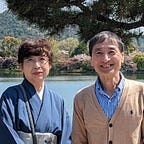An Intimate Exploration into Kyoto: Serene Solitudes & Timeless Tales
— Article 9: Daitokuji, a Repository of Hidden Splendors —
Nestled in the heart of Kyoto lies the Daitokuji Zen Temple. Established in the 14th century, Daitokuji stands as a testament to Japan’s rich cultural tapestry, comprising a central temple and 24 unique subsidiary temples, each a repository of distinct histories, architectural marvels, exquisite gardens, and hidden treasures. In this exploration, I delve into the entrancing realms of two such temples, Obaiin and Ryugenin, which I had the privilege of visiting on February 28th, 2023.
Obaiin: A Legacy of Nobunaga Oda
Founded in the 16th century by the iconic Nobunaga Oda, Obaiin is a marvel of Zen aesthetics. The temple grounds are a symphony in green, with gardens blanketed in lush moss and punctuated by the serene Sekitei, a quintessential Zen rock garden.
The architectural splendor of Obaiin is further accentuated by an unexpected cultural gem — the Hina dolls, traditionally displayed for Hinamatsuri, the annual girls’ festival that has been celebrated since almost 1000 years ago. These dolls represent the Emperor and Empress on the stairs, three court ladies, five musicians, two ministers, and three servants. Though most Japanese families with girls have Hina dolls, discovering them in a Zen temple was an intriguing paradox, bridging the secular and sacred realms of Japanese culture.
Ryugenin: Chronicles of Feudal Lords
A short journey away is Ryugenin, another 16th-century establishment with its own narrative. The temple’s Sekitei presents a stark yet serene contrast to Obaiin’s, while the architectural nuances further distinguish it. In Ryugenin, I found a historically significant artifact: a Go board that was once the silent arbiter of strategy between Hideyoshi Toyotomi and Ieyasu Tokugawa. During the era when Hideyoshi wielded paramount authority over Japan, with Ieyasu as his deputy, this board was a quiet witness to their contemplative games. The narrative takes a pivotal turn following Hideyoshi’s demise, as Ieyasu vanquished Hideyori, Hideyoshi’s heir. This decisive victory marked the dawn of the Tokugawa Shogunate, an epoch-defining Japanese governance and culture from 1603 until the Meiji Restoration in 1867.
For those unacquainted with the tranquil elegance of Kyoto, I recommend beginning your journey with my inaugural piece, “An Intimate Exploration into Kyoto: Serene Solitudes & Timeless Tales — Article 1: Lesser Known Gems.”
Await the unveiling of my next article, where I will guide you through the mystical and historical depths of the “Kiyomizu-Dera, The Most Famous Temple in Kyoto.”
